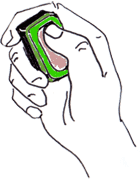by Cathy Hughes
 Obedience classes have gone through an amazing metamorphosis in the past two decades. Methods well grounded in the science of operant conditioning in general and positive reinforcement in particular are being used routinely in the training of service dogs and other “dogs with jobs.” A great number of obedience class instructors have embraced these methods and offer them to their students in all levels of training. The pet dog obedience classes may be where these changes are met with the most astonishment because many pet owners have not taken a basic dog obedience class since they adopted their last pup. In some cases this could be over 15 years ago. The leap from “traditional” forceful methods to positive reinforcement may be a bit much to swallow for these pet dog owners at first. The good news is that these changes are effective, safe and fun! The pet owner who is considering enrollment in such a class can do much to enhance the benefits of the new knowledge they are about to receive by doing some pre-class preparation.
Obedience classes have gone through an amazing metamorphosis in the past two decades. Methods well grounded in the science of operant conditioning in general and positive reinforcement in particular are being used routinely in the training of service dogs and other “dogs with jobs.” A great number of obedience class instructors have embraced these methods and offer them to their students in all levels of training. The pet dog obedience classes may be where these changes are met with the most astonishment because many pet owners have not taken a basic dog obedience class since they adopted their last pup. In some cases this could be over 15 years ago. The leap from “traditional” forceful methods to positive reinforcement may be a bit much to swallow for these pet dog owners at first. The good news is that these changes are effective, safe and fun! The pet owner who is considering enrollment in such a class can do much to enhance the benefits of the new knowledge they are about to receive by doing some pre-class preparation.
One of the most underrated tools an owner can use when searching for a class is curiosity. While seeking recommendations and tabulating years of training experience of local obedience class instructors are important, part of the shopping-around process for an obedience class should include researching the methods taught in the classes under consideration. Ask what exercises will be taught in class. Arrange to observe some classes or meet the instructor. Request a recommended reading list. Go to the library or search the net for more information about the techniques you will be exposed to, making certain the class you enroll in is the best one for you! Doing some research before attending the first class session can save you some time and confusion.The successes of many of the training methods currently used by obedience schools depend on knowing what motivates the individual dog to work with its owner. It follows that the more an owner knows about what makes his dog tick prior to initiating a training regime, the more successful the dog-owner team will be in class. Owners will be better prepared for any obedience class if they observe their dogs and interact with them often under different circumstances and in various locations. What are the dog’s likes, dislikes and fears? What foods does he like? Does he like to play with toys on his own, with other dogs or with people? Is he a wild and crazy guy, or a couch potato at heart? Getting to know your dog can be time consuming, but it is a must to be an effective trainer.
One goal of obedience instructors today is to give dog owners the knowledge to train their dogs to be well-behaved using methods that are safe for the dog and all family members. Since most effective training methods are based on positive motivation, gone are the days of a leash, collar and dog being the only items needed to attend obedience school. Most current methods use food, play drive, praise, or a combination of all of these as a base for initial training. Today’s beginning obedience class equipment list may include various types of treats, a toy or two, a fanny pack (if you do not relish putting treats in your pocket), a clicker (in the case of a Clicker Class), some type of target (if targeting is to be introduced in your class), a notebook (to take notes augmenting any handouts given in class), a 15-20′ long line and a bag to carry all of the dog’s training stuff in. Your instructor will supply you with a list tailor-made for her class upon enrolling or during the first class session.
Finally, add to all that has been covered current shot records, comfortable clothing, a healthy dog, and an open mind. Many new ideas about teaching in general and dog training in particular are about to come your way. Take advantage of this knowledge by attending everyclass and asking questions. In order to train your dog successfully, daily implementation of your newly learned skills is a must.
